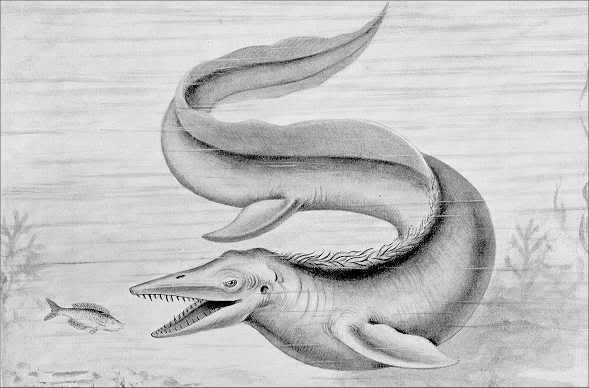Post by Barry the Baryonyx on Jul 8, 2007 21:18:36 GMT -5
Mosasaur

Public domain, retrieved from copyrightexpired.com
This image is in the public domain because its copyright has expired in the United States and those countries with a copyright term of life of the author plus 100 years or less.
Mosasaurs, from Latin Mosa meaning the 'Meuse river' in the Netherlands, where the first fossil remains were discovered about 1780, and Greek sauros meaning 'lizard', were serpentine marine reptiles. These ferocious marine predators are considered by some experts to be closely related to snakes, due to extreme similarities in jaw and skull anatomies. Mosasaurs were not dinosaurs but "lepidosaurs". These predators evolved from semi-aquatic squamates known as the "aigialosaurs", close relatives of modern-day monitor lizards, in the Early Cretaceous Period and became the dominant marine predators, during the last 25 million years of the Cretaceous Period (Turonian-Maastrichtian), with the extinction of the last "ichthyosaurs" and the decline of the Cretaceous "plesiosaurs" and "pliosaurs".
Known genera include "Clidastes", "Mosasaurus", "Prognathodon", "Globidens", "Plotosaurus", "Plesiotylosaurus", "Carinodens", "Dallasaurus", "Igdamanosaurus", "Halisaurus", "Tylosaurus", Platecarpus, Selmasaurus, Plioplatecarpus, Amphekepubis, "Goronyosaurus", "Liodon", "Moanasaurus", "Pluridens", "Lakumasaurus", "Yaguarasaurus", "Eonatator", "Hainosaurus", "Tethysaurus", "Angolasaurus", "Kourisodon" and "Russellosaurus".
Description
Mosasaurs breathed air and were powerful swimmers that were well-adapted to living in the warm, shallow epicontinental seas prevalent during the Late Cretaceous Period. Mosasaurs were so well adapted to living in shallow epicontinental seas that they gave birth to live young, rather than return to the shore to lay eggs, as sea turtles do.
The smallest-known Mosasaur was "Carinodens belgicus", which was about 3 to 3.5 m long and probably lived in shallow waters near shore, cracking mollusks and sea urchins with its bulbous teeth. Larger mosasaurs were more typical: mosasaurs ranged in size up to 17 m: "Hainosaurus" holds the record for longest mosasaur, at 17.5 m.
Mosasaurs had a body shape similar to that of modern-day monitor lizards (varanids), but were more elongated and streamlined for swimming. Their limb bones were reduced in length and their paddles were formed by webbing between their elongated digit-bones. Their tails were broad and supplied the locomotor power. This method of locomotion may have been similar to that used by the conger eel or sea snakes today. The animal may have lurked and pounced rapidly and powerfully on passing prey, rather than hunting for it.
Mosasaurs had a double-hinged jaw and flexible skull (much like that of a snake), which enabled them to gulp down their prey almost whole, a snakelike habit that has helped identify the gut contents fossilized within mosasaur skeletons. A skeleton of "Tylosaurus proriger" from South Dakota included remains of the diving seabird "Hesperornis", a marine bony fish, a possible shark and another, smaller mosasaur (Clidastes). Mosasaur bones have also been found with shark teeth embedded in them.
Based on features such as the double row of pterygoid teeth on the palate, double-hinged jaw, modified/reduced limbs and probable locomotion, many researchers believe that snakes and mosasaurs may have had a common ancestor. This theory was first suggested in 1869, by "Edward Drinker Cope", who coined the term "Pythonomorpha" to include them. The idea lay dormant for more than a century, before being revived in the 1990s.
Environment
Sea levels were high during the Cretaceous Period, causing marine transgressions in many parts of the world and a great inland seaway in what is now North America. Mosasaur fossils have been found in the Netherlands, in Sweden, in Africa, in Australia, in New Zealand and on Vega Island, off the coast of Antarctica. In Canada and the United States, complete or partial specimens have been found in Alabama, Mississippi, Tennessee, and Georgia and in almost all the states covered by the seaway: Texas, southwest Arkansas, New Mexico, Kansas, Colorado, Nebraska, the Dakotas and Montana. Mosasaurs are also known from California, Mexico, and Peru.
Many of the 'dinosaur' remains found on New Zealand—a volcanic island arc that has never been part of a continent—are actually mosasaurs and plesiosaurs, another group of Mesozoic predatory marine reptiles.
Discovery
The first publicized discovery of a fossil mosasaur (the first mosasaur remains were found 20 years earlier but were generally unknown to scientists of the day) preceded any dinosaur fossil discoveries and drew the Age of Enlightenment's attention to the existence of fossilized animals; the specimen was discovered in 1780 by quarry-workers in a subterranean gallery, who quickly alerted Doctor C. K. Hoffman, a surgeon and fossil-hunter in the Dutch city of Maastricht, although rights of ownership lay with a canon of Maastricht, as owner of the overlying land.
Dr. Hoffman's correspondence among men of science made the find famous. When the Revolutionary forces occupied Maastricht, the carefully-hidden fossil was uncovered, betrayed, it is said, by a case of wine and transported to Paris, where Georges Cuvier was able to describe it for science, although le grand animal fossile de Maastricht was not actually described as a Mosasaur ('Meuse reptile') until 1822 and not given its official name, "Mosasaurus hoffmanni", until 1829. Several sets of mosasaur remains, that had been discovered earlier at Maastricht, have been on display in the Teylers Museum, Haarlem, since about 1770.
The Maastricht limestone beds were rendered so famous they have given their name to the ultimate 6-million-year epoch of the Cretaceous: the Maastrichtian.
Evoutionary antecedents
Based on features such as the loosely-hinged jaw, modified/reduced limbs and probable locomation, many researchers believe that snakes may be descended from mosasaurs, a suggestion advanced in 1869, by Edward Drinker Cope, who coined the term "Pythonomorpha" to include them. The idea lay dormant for more than a century, to be revived in the 1990s.
On 2005-11-16, research reported in Netherlands Journal of Geosciences, confirmed that the recently uncovered "Dallasaurus turneri" is an early link between land-based moniter lizards (such as the Komodo dragon) and the aquatic mosasaurs.
Copyright © 2007 Answers Corporation


 Is it just us?
Is it just us?